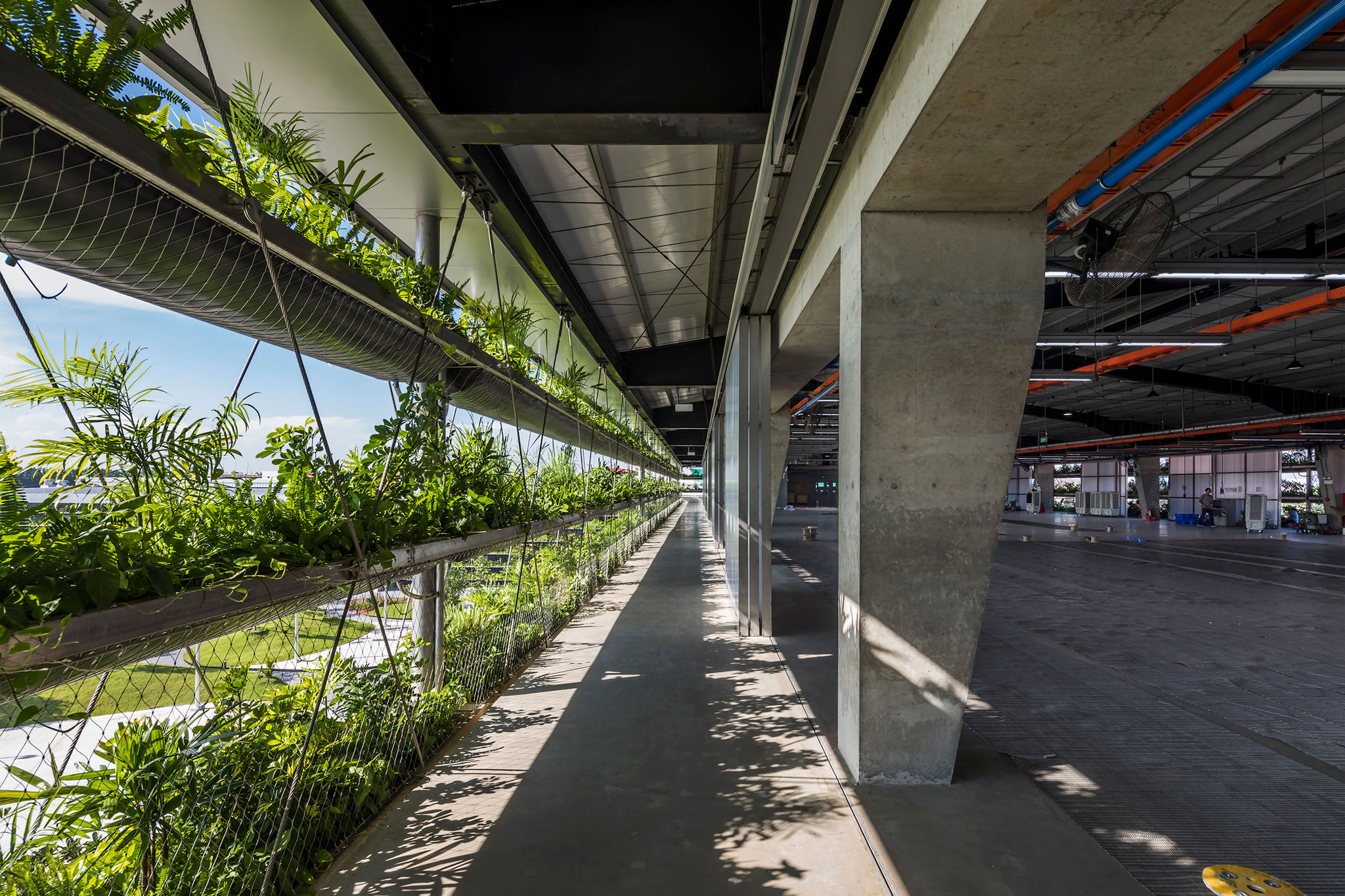One of these structures accommodates the reception area, the cafeteria with a kitchen, coatrooms and office spaces over two levels. In the second and largest building, the production zones are stacked over three storeys. The third building, which is L-shaped, is home to storage areas and a moped garage for employees.

Jakob Factory by rollimarchini architekten + G8A Architects. Photograph by Oki Hiroyuki.
In order to minimize energy consumption, the architects decided in favour of a proven construction principle from tropical regions: beneath a large, sheltering roof, open, permeable façades surround the interior spaces. This ensures natural ventilation. In addition, simple fans support a constant airflow that lowers the perceived temperature in the buildings by several degrees.
This approach alone is not sufficient to provide complete heat and rain protection and was solved in a complementary way by "hanging gardens" made of planters suspended from stainless steel ropes and nets. The green walls not only shade the interior spaces and filter pollutants from the air, but they also lower the building temperature through evaporation.
Some of the spaces behind this planted curtain are completely open, such as the cafeteria. Others are delimited with added polycarbonate multi-skin sheets, and others feature ceiling-high, sliding multi-skin panels that enable the precise adjustment of the size of the opening.

Jakob Factory by rollimarchini architekten + G8A Architects. Photograph by Oki Hiroyuki.

Jakob Factory by rollimarchini architekten + G8A Architects. Photograph by Oki Hiroyuki.
Project description by rollimarchini architekten + G8A Architects
The Jakob Factory project offered the design partnership of rollimarchini architekten from Bern and Swiss-born G8A Architects the unique opportunity to propose a highly innovative and highly specific manufacturing space, set to become a design reference for tropical sustainable architecture.
The factory houses the specialist steel rope producers Jakob Rope Systems, a high-quality manufacturing organization, specializing in custom-made steel meshing used for scales of private to industrial usage. The partnership of organizations applied their pillar value of sustainability, both environmental and social, to all phases of the design process, from conception to execution and projected project developments.
The 30,000m² site area is placed in the centre of an industrial park 50 kilometres north of Ho Chi Minh City, the economic capital of Vietnam. Ever since Vietnam’s economic reform in 1986 the country has seen a grappling rise in national GDP, with industries and populations moving from a primarily agricultural industry to a focused industrial practice. The past ten years have seen the doubling of industrial parks constructed on the city outskirts from the North to the South of the country. With lightning speed, few regulations and priorities focused on economic gain rather than environmental impact, many of these zones have witnessed highly polluting and detrimental construction practices, transforming the previously porous land into large zones of impermeable slab development.

Jakob Factory by rollimarchini architekten + G8A Architects. Photograph by Oki Hiroyuki.

Jakob Factory by rollimarchini architekten + G8A Architects. Photograph by Oki Hiroyuki.
The Jakob Factory proposal was seen as a unique opportunity for rollimarchini and G8A to propose an alternative to these detrimental practices, presenting a strategic land-saving project with focus elements of passive design. Proposing an environmentally friendly alternative to the typically horizontally spread manufacturing buildings. Jakob Factory offers an innovative vertical densification strategy, stacking the usable zones on superimposed slats. This robust design avoids unnecessary ground usage negating needless land development, while also offering workers agreeable outdoor spaces. However, the proposition necessitates the imposing facades taking on important functions; having to provide both shading and rain protection, a service previously asked from the roofing.
Taking reference from the traditional tropical architecture of the region the design has developed with a porous façade devised as a lush plantation “skin”, the suspended structure is supported by a two-layer rope network stretched from the ground to the roof. The horizontal geotextile planters not only filter rain and sun but also contribute to lowering the atmospheric temperature through evaporation, acting as air purifiers and dust particle binders.
The intelligent distribution of workspaces combined with the plantation façade and completely modular interior walls provide a comfortable working space, a pioneering initiative as Jakob Factory becomes the first project in Vietnam proposing completely naturally ventilated manufacturing halls.















































